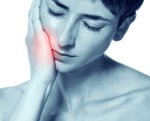Migraine Treatment -
an FDA approved
drug-free option
Migraine sufferers would love a migraine treatment that is drug-free AND actually works better than the drugs; and being approved by the FDA would be a bonus too.
Such a migraine treatment DOES exist, and has done so for over 15 years, but is not widely known about because the medical profession have been slow to adopt it.
READ ON to find out more.
But first, we need to look at migraines in more detail.
A migraine attack is generally agreed to be a neurological disorder that causes intense pulsating or throbbing pain in the head. Many migraine sufferers dislike including the word "headache", as they say this makes non-suffers think that a migraine is just a really bad headache.
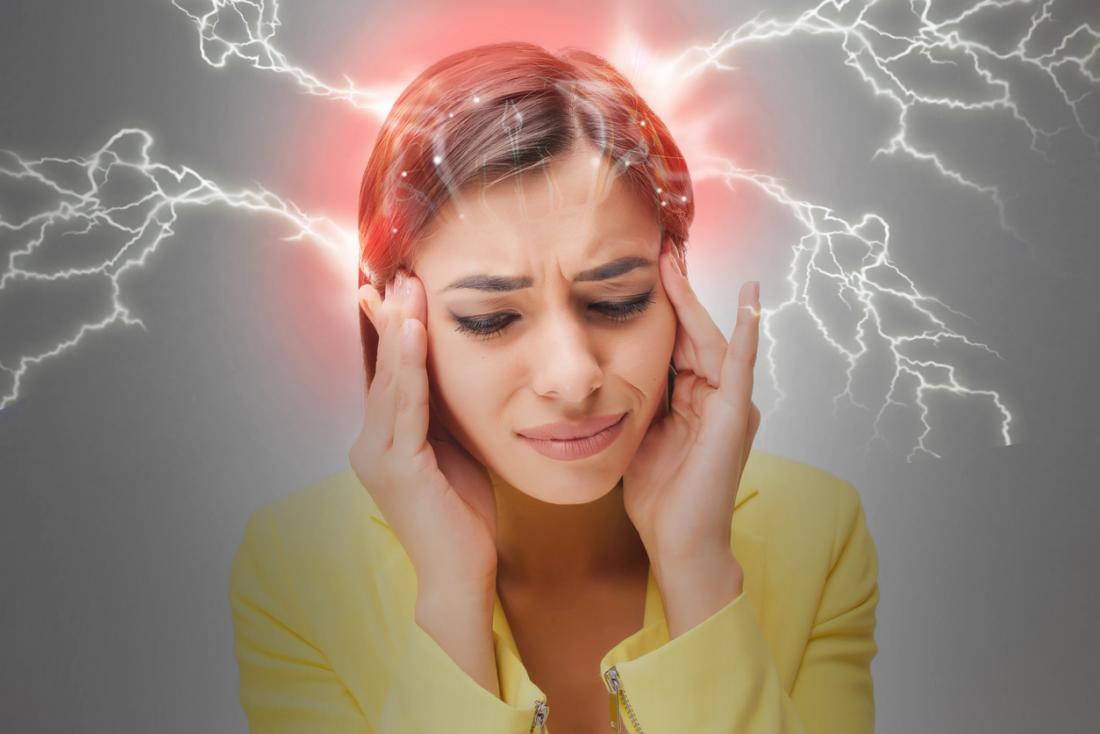
Migraine Treatment
But a migraine attack is completely different to a normal headache. In fact. the World Health Organization includes migraines in its list of the Top 20 most debilitating conditions. This means that a migraine attack can stop you in your tracks, making you head for a silent, dark room to lie down and wait out the pain.
About 20% of sufferers will experience an "aura" before the onset of the full migraine. This warns them that a migraine is imminent. This is quite different to the aura experienced by many epileptics before a seizure. The migraine aura usually involves visual disturbances such as flashing lights and zig-zag lines, as well as vertigo and tingling in the hands.
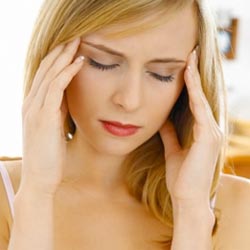 migraine treatment
migraine treatmentWhat are the causes of migraines?
There does not seem to be one single cause that the medical profession can agree on, but there are some factors that seem to act as triggers in some people;
- A history in the family of migraines. This means that one or both parents and grandparents may have prone to migraine attacks.
- Certain foods, typically red wine, cheese, and chocolate.
- Hormonal changes during a woman's monthly cycle.
- Excessive stress.
- The weather, where there are sudden changes in barometric pressure or temperature.
- Intense night-time jaw clenching, particularly when combined with any of the above.
Migraine Treatment
As you might expect for such a poorly-understood condition, there are many migraine treatment options available, some of which work quite well, and others that don't work well at all, but seem to persist on the internet! I really dislike internet "fake news"!
Let's take a look at the standard options to prevent migraine or treat migraine once it has started;
1. Drugs. The main drugs used in migraine therapy are;
- Topamax, which you swallow,
- and Botox, which can be injected into nerve ganglions to "freeze" them.
2. Natural remedies. The natural migraine treatments that have some science behind them are;
- Avoid your food triggers, if you know they can set off a migraine for you. The main ones are usually red wine, cheese and chocolate.
- Relaxation therapy supported by a biofeedback device.
- Apply an ice pack to your neck (all around your neck) to cool the carotid arteries.
- Peppermint oil, applied directly to the forehead and temples.
- Ginger, taken in the form of ginger tea, or chewing the raw ginger root.
The drug options have been the subject of many studies to see if they actually work. They Do work, but not for everyone, and the improvement in migraine frequency and intensity is about 40%. This means that migraines occurred 40% less frequently than before, and when a migraine DID occur, it was about 40% less intense than normal.
By a fluke, the actual number of sufferers that drugs help is also around 40%, which means that 60% of migraine sufferers had only slight or NO improvement with the drugs.
In a lot of other fields of medicine, this rate of success would be seen as pretty poor. The fact that Topamax and Botox are still the main-line drugs for migraine just goes to show that there's nothing better out there. At least, no better drugs.
BUT there are other options . . .
The natural remedies I have listed have also been the subject of scientific research, and have been shown to be of some benefit for some people. But no magic bullet.
So, what else is there?
Migraine Treatment - the alternative solution
In an address to the 2018 International Migraine Trust Symposium in London, England, American doctors Blumenfeld and Boyd presented evidence that the NTI bite splint developed by Dr Boyd outperforms the traditional drug-based therapies - and by a wide margin!
To prove this, they used a questionnaire called the 6-question Head Impact Test, also called the HIT6 for short. It is aimed at assessing the degree of negative impact that migraines have on the quality of life of sufferers.
The final score of the HIT6 falls into one of 4 categories;
- Below 49 = NO impact on quality of life.
- 50 - 55 = Some impact on quality of life, moderate pain.
- 56 - 59 = Substantial impact on quality of life, severe pain.
- 60 + = Severe impact on quality of life, disabling pain.
This last group where the score is over 60 is the largest group, where most migraine sufferers find themselves.
SO, how did Dr Blumenfeld and Dr Boyd use the HIT6 questionnaire?
They asked migraine sufferers to fill out the HIT6, after dividing patients into 1 of 3 groups;
- Group 1 were treated with Topamax.
- Group 2 were treated with Botox.
- Group 3 were treated with the NTI night-time bite splint.
Both Topamax and Botox were able to reduce the HIT6 score in their groups from 65 (ie. the top, most severely affected) group down to 59 - just into the next group down. This is a significant improvement in the quality of life for many people, and it shows that the drugs DO work. For some people.
HOWEVER, the NTI scored even better, reducing the HIT6 score down from 65 to 54 - that is a reduction down by 2 whole levels. This put the people in the NTI group into the 55 - 59 level: "some impact on quality of life, moderate pain".
That's a huge change from the 60+ level where they started: "severe impact on quality of life, disabling pain."
AND it's drug - free.
AND it's approved by the FDA as a treatment for migraine.
Migraine Treatment
What is the NTI, and how does it work?
The NTI is a small acrylic splint, custom-made for each person, that fits over the 4 lower front incisors. That's it. It doesn't cover any more than 4 front teeth on the bottom jaw.
You have to see your dentist to get one made, and it has to fit very precisely. You put it over your teeth when you go to bed at night, and take it out when you wake up in the morning. It works while you are sleeping.
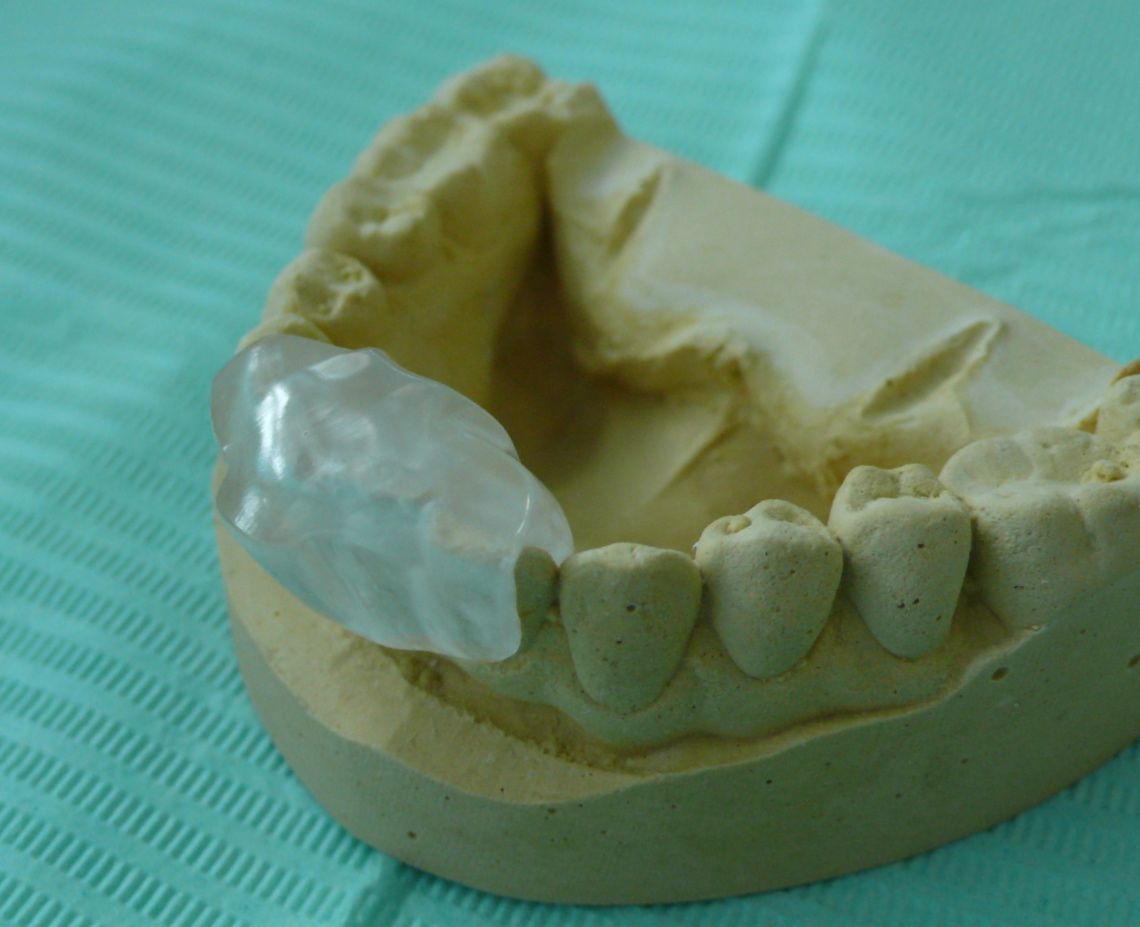 An NTI splint on a laboratory model
An NTI splint on a laboratory model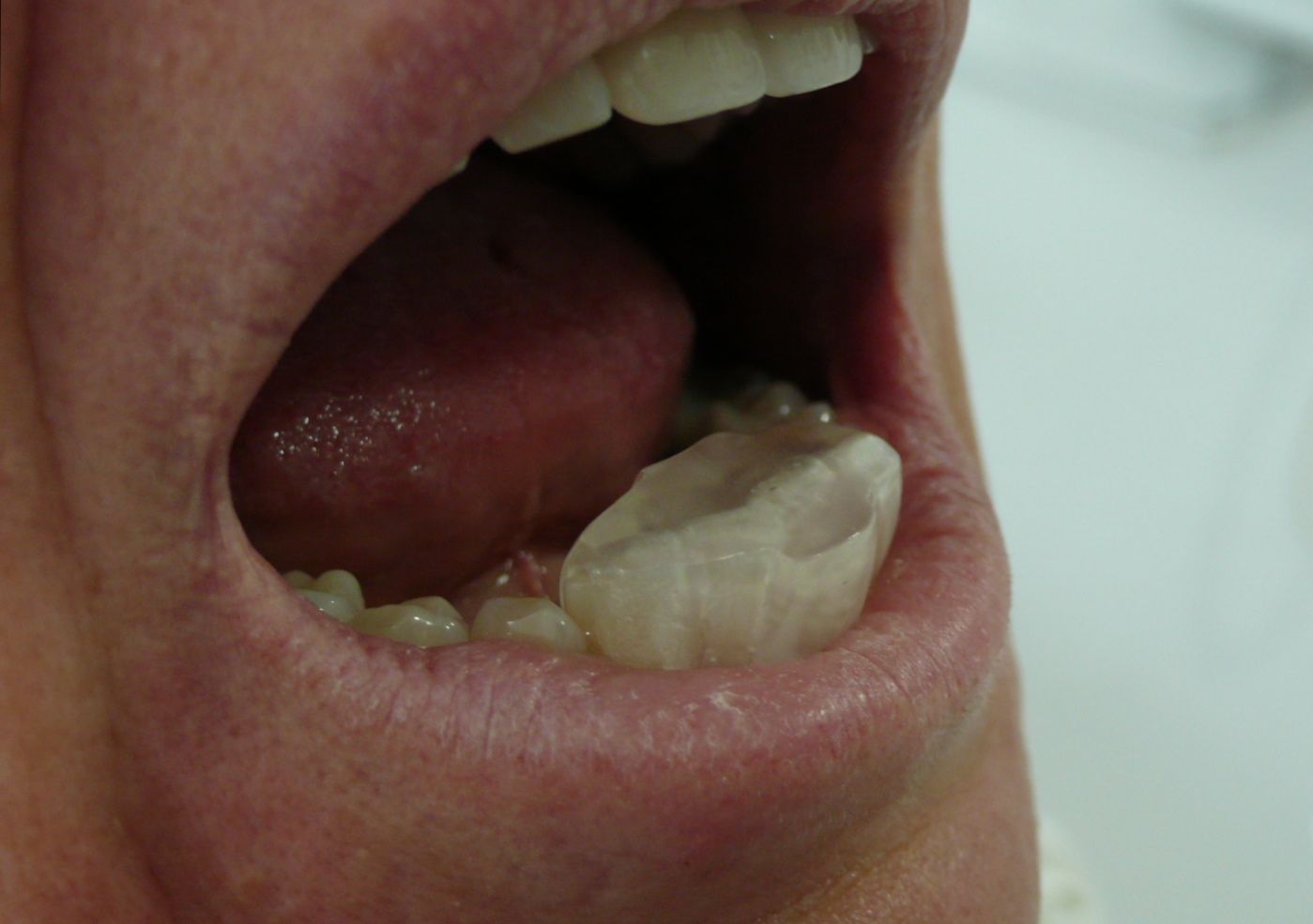 The NTI splint on the lower front teeth
The NTI splint on the lower front teeth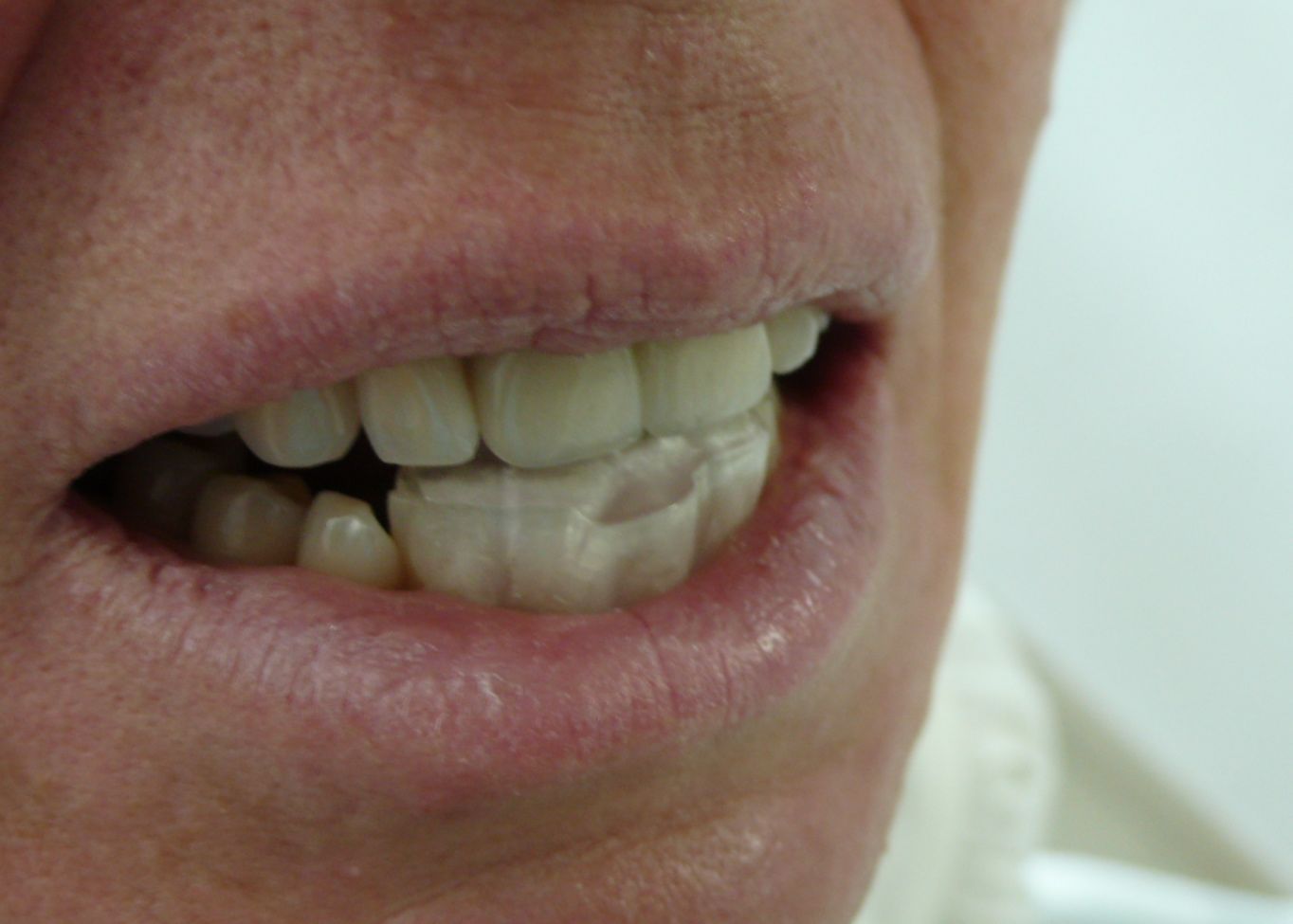 Patient biting on the NTI splint
Patient biting on the NTI splintIn the images above, you can see how the NTI is made in the laboratory to fit over the lower front teeth.
Then the patient can put it on their own teeth - it snaps into place with a click - and then their upper teeth rest on the splint.
How does this work as a migraine treatment?
It works by creating a slight gap between the back teeth. You can only make contact with the front teeth, biting on to the NTI splint.
This reduces the intensity of jaw clenching during sleep by 70%, minimizing the noxious nociceptive input the the trigeminal sensory nucleus.
Confused? Here is a video of the London Symposium presentation by Dr. Boyd; It may explain things better to see it!
BUT IN THE MEANTIME, here's a simple test you can carry out at home to convince yourself that the NTI really does work:
Put your finger tips up on your temples,above the outer corners of your eyes. Then clench your back teeth together, and feel how those temple muscles really bulge! (You may have to move your finger tips around a little until you feel the muscle working as you clench and release.)
Next, get a pencil and put the blunt end between your top and bottom front teeth. Bite down onto the blunt end with your front teeth, so that your back teeth are held apart. Now try to feel those muscle in your temple again - they will be bulging MUCH less!
This little test shows that by creating contact on your front teeth only, and maintaining your back teeth out of contact reduces the clenching intensity by around 70%. By that I mean it's 70% less than normal!
Below is a YouTube video explaining the NTI migraine treatment in a more straightforward manner:
I hope this guide to migraine treatment options has been helpful.


